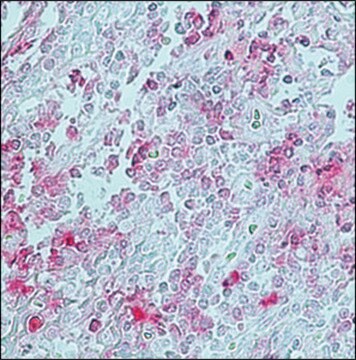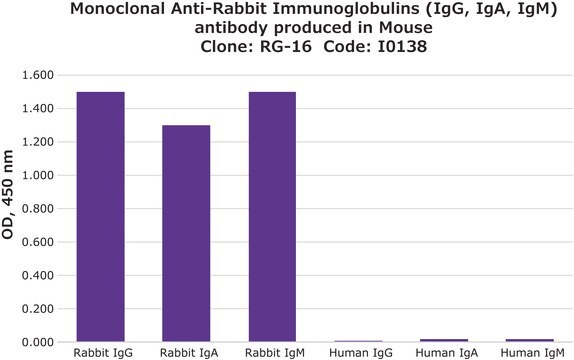A2074
Monoclonal Anti-Rabbit Immunoglobulins–Peroxidase antibody produced in mouse
clone RG-16, purified immunoglobulin, lyophilized powder
Synonyme(s) :
Monoclonal Anti-Rabbit Immunoglobulins (IgG, IgA, IgM)
About This Item
Produits recommandés
Source biologique
mouse
Niveau de qualité
Conjugué
peroxidase conjugate
Forme d'anticorps
purified immunoglobulin
Type de produit anticorps
secondary antibodies
Clone
RG-16, monoclonal
Forme
lyophilized powder
Espèces réactives
rabbit
Ne doit pas réagir avec
pig, chicken, bovine, horse, human, guinea pig, turkey, rat, canine, goat, feline, sheep
Conditionnement
vial of 0.5 mL
Technique(s)
direct ELISA: 1:30,000
immunohistochemistry (formalin-fixed, paraffin-embedded sections): 1:100 using human tissue
western blot (chemiluminescent): 1:160,000
Isotype
IgG1
Température de stockage
2-8°C
Modification post-traductionnelle de la cible
unmodified
Vous recherchez des produits similaires ? Visite Guide de comparaison des produits
Description générale
Spécificité
Application
- western blotting
- immunoblotting
- immunoprecipitation
- enzyme linked immunosorbent assay (ELISA)
- immunohistochemistry
Forme physique
Notes préparatoires
Clause de non-responsabilité
Vous ne trouvez pas le bon produit ?
Essayez notre Outil de sélection de produits.
Mention d'avertissement
Warning
Mentions de danger
Conseils de prudence
Classification des risques
Skin Sens. 1
Code de la classe de stockage
11 - Combustible Solids
Classe de danger pour l'eau (WGK)
WGK 2
Équipement de protection individuelle
Eyeshields, Gloves, type N95 (US)
Certificats d'analyse (COA)
Recherchez un Certificats d'analyse (COA) en saisissant le numéro de lot du produit. Les numéros de lot figurent sur l'étiquette du produit après les mots "Lot" ou "Batch".
Déjà en possession de ce produit ?
Retrouvez la documentation relative aux produits que vous avez récemment achetés dans la Bibliothèque de documents.
Notre équipe de scientifiques dispose d'une expérience dans tous les secteurs de la recherche, notamment en sciences de la vie, science des matériaux, synthèse chimique, chromatographie, analyse et dans de nombreux autres domaines..
Contacter notre Service technique









